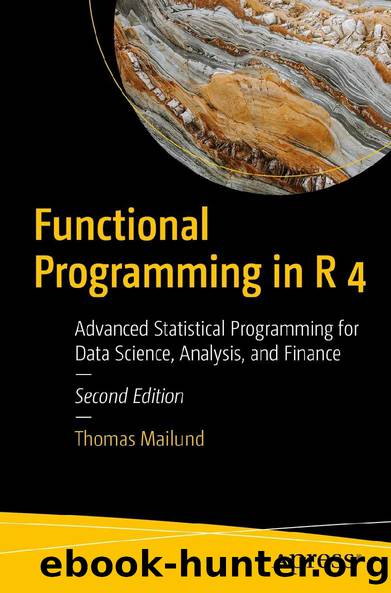Functional Programming in R 4 by Unknown

Author:Unknown
Language: eng
Format: epub, pdf
Chapter 4 SCope and CloSureS
Environment Chains, Scope, and
Function Calls
When you call a function in R, you first create an empty environment for that function. That environment is where its parameters will be stored, and any local variables the function assigns to will also go there. Whenever R needs to look up a value, it will look in this environment. If it finds the variable, you get the value in this table. If it doesnât, R doesnât just give up, however. It continues the search.
Environments are not only table but chains of tables. Each environment has a âparentâ (you can use the parent.env() function to get it), and if a lookup fails for an environment, R will look in the parent instead. If it fails there, it will try the grandparent, and it will continue as long as there are environments.
Consider this code:
f < - function(x) {
sqrt(sum(x + y))
}
x < - 1:10
y < - 1:10
f(x**2)
71
Chapter 4 SCope and CloSureS
Figure 4-2. The local and global environments are connected through a parent pointer
## [1] 20.97618
We define three variables, f, x, and y, in the global environment, where f is a function. Then we call the function, creating a local environment where fâs argument x will be placed; see Figure 4-2.
The x in the local and the global environments refers to different values, and if we look for the value of x inside the function, we get the one in the local environment; see Figure 4-3. The sqrt, sum, and y names used in the function body are not defined in the local environment. If we only had environments as tables, we wouldnât be able to run this code. The parent environment, however, allows us to find nonlocal variables. When R cannot find y in the local environment, it will go to the parent environment, which is the global environment, and find it there; see Figure 4-4.
The sqrt and sum variables are also not defined in the local environment, so R will also look for them in the parent, but they are not defined in the global environment either. Although I will not look beyond the global environment in the rest of this book, the environment 72
Chapter 4 SCope and CloSureS
chain goes deeper than that. After the global environment, you will find environments that hold names from loaded packages, which is why you can use functions from packages. Once you are through them, you get to the so-called âbase environment,â where you find the base R functions (you can get hold of it with the baseenv() function) and then an empty environment that terminates the search. It is in this base environment we find sum and sqrt; see Figure 4-5. The mechanism is the same all the way down, so if you understand how it works between functions and the global environment, you will also understand how environments work everywhere1.
Figure 4-3. Finding local variable x
1 Packages also use the environment system to differentiate between public and private names, but not through a separate mechanism.
Download
This site does not store any files on its server. We only index and link to content provided by other sites. Please contact the content providers to delete copyright contents if any and email us, we'll remove relevant links or contents immediately.
Building Data Science Solutions with Anaconda by Dan Meador(3873)
Simplify Big Data Analytics with Amazon EMR by Sakti Mishra(2726)
Building Modern CLI Applications in Go by Marian Montagnino(1489)
Getting Started with Forex Trading Using Python by Alex Krishtop(1418)
Simplify Big Data Analytics With Amazon EMR: A Beginner's Guide to Learning and Implementing Amazon EMR for Building Data Analytics Solutions by Sakti Mishra(1117)
Natural Language Processing Fundamentals by Sohom Ghosh(740)
Sebastian Raschka Python Machine Learning Unlock deeper insights into Machine Leaning with this vital guide to cutting-edge predictive analytics by Unknown(681)
+ Excel for Finance and Accounting: Learn how to optimize Excel formulas and functions for financial analysis by Suraj Kumar Lohani(577)
Mastering Data Analysis with Python: A Comprehensive Guide to NumPy, Pandas, and Matplotlib by Rajender Kumar(436)
Essential Guide to LLMOps by Ryan Doan;(409)
Fundamentals of Data Engineering by Joe Reis and Matt Housley(408)
Statistical Data Analysis Using SAS Intermediate Statistical Methods 2nd Edition by Unknown(398)
Data Wrangling Using Pandas, SQL, and Java by Oswald Campesato(350)
Excel 2019 PivotTables: Easy Excel Essentials 2019 - Book 1 by M.L. Humphrey(348)
Hacking SaaS by Eric Mersch(299)
Microsoft PowerPoint - BATSA presentation D Crow - web.ppt by denslows(292)
ChatGPT Millions: Ideas to Generate Your First Million Using ChatGPT and AI by Johnson Omar(282)
MICROSOFT OFFICE 365 FOR BEGINNERS & ADVANCED USERS: THE MOST UPDATED USERG GUIDE TO LEARN MICROSOFT OFFICE 365 (WORD, EXCEL, POWERPOINT, & PUBLISHER) by GIBSON CRYSTAL(267)
Grammatical Framework: Programming with Multilingual Grammars (Studies in Computational Linguistics) by Aarne Ranta(254)
